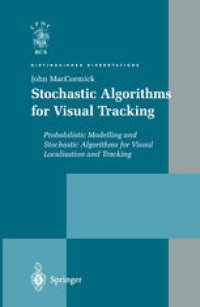
Ebook: Stochastic Algorithms for Visual Tracking: Probabilistic Modelling and Stochastic Algorithms for Visual Localisation and Tracking
Author: John MacCormick (auth.)
- Tags: Computer Imaging Vision Pattern Recognition and Graphics, Algorithm Analysis and Problem Complexity
- Series: Distinguished Dissertations
- Year: 2002
- Publisher: Springer-Verlag London
- Edition: 1
- Language: English
- pdf
A central problem in computer vision is to track objects as they move and deform in a video sequence. Stochastic algorithms -- in particular, particle filters and the Condensation algorithm -- have dramatically enhanced the state of the art for such visual tracking problems in recent years. This book presents a unified framework for visual tracking using particle filters, including the new technique of partitioned sampling which can alleviate the "curse of dimensionality" suffered by standard particle filters. The book also introduces the notion of contour likelihood: a collection of models for assessing object shape, colour and motion, which are derived from the statistical properties of image features. Because of their statistical nature, contour likelihoods are ideal for use in stochastic algorithms. A unifying theme of the book is the use of statistics and probability, which enable the final output of the algorithms presented to be interpreted as the computer's "belief" about the state of the world. The book will be of use and interest to students, researchers and practitioners in computer vision, and assumes only an elementary knowledge of probability theory.
A central problem in computer vision is to track objects as they move and deform in a video sequence. Stochastic algorithms -- in particular, particle filters and the Condensation algorithm -- have dramatically enhanced the state of the art for such visual tracking problems in recent years. This book presents a unified framework for visual tracking using particle filters, including the new technique of partitioned sampling which can alleviate the "curse of dimensionality" suffered by standard particle filters. The book also introduces the notion of contour likelihood: a collection of models for assessing object shape, colour and motion, which are derived from the statistical properties of image features. Because of their statistical nature, contour likelihoods are ideal for use in stochastic algorithms. A unifying theme of the book is the use of statistics and probability, which enable the final output of the algorithms presented to be interpreted as the computer's "belief" about the state of the world. The book will be of use and interest to students, researchers and practitioners in computer vision, and assumes only an elementary knowledge of probability theory.
A central problem in computer vision is to track objects as they move and deform in a video sequence. Stochastic algorithms -- in particular, particle filters and the Condensation algorithm -- have dramatically enhanced the state of the art for such visual tracking problems in recent years. This book presents a unified framework for visual tracking using particle filters, including the new technique of partitioned sampling which can alleviate the "curse of dimensionality" suffered by standard particle filters. The book also introduces the notion of contour likelihood: a collection of models for assessing object shape, colour and motion, which are derived from the statistical properties of image features. Because of their statistical nature, contour likelihoods are ideal for use in stochastic algorithms. A unifying theme of the book is the use of statistics and probability, which enable the final output of the algorithms presented to be interpreted as the computer's "belief" about the state of the world. The book will be of use and interest to students, researchers and practitioners in computer vision, and assumes only an elementary knowledge of probability theory.
Content:
Front Matter....Pages i-ix
Introduction and background....Pages 1-7
The Condensation algorithm....Pages 8-37
Contour likelihoods....Pages 38-64
Object localisation and tracking with contour likelihoods....Pages 65-91
Modelling occlusions using the Markov likelihood....Pages 92-111
A probabilistic exclusion principle for multiple objects....Pages 112-123
Partitioned sampling....Pages 124-143
Conclusion?....Pages 144-145
Back Matter....Pages 155-174
A central problem in computer vision is to track objects as they move and deform in a video sequence. Stochastic algorithms -- in particular, particle filters and the Condensation algorithm -- have dramatically enhanced the state of the art for such visual tracking problems in recent years. This book presents a unified framework for visual tracking using particle filters, including the new technique of partitioned sampling which can alleviate the "curse of dimensionality" suffered by standard particle filters. The book also introduces the notion of contour likelihood: a collection of models for assessing object shape, colour and motion, which are derived from the statistical properties of image features. Because of their statistical nature, contour likelihoods are ideal for use in stochastic algorithms. A unifying theme of the book is the use of statistics and probability, which enable the final output of the algorithms presented to be interpreted as the computer's "belief" about the state of the world. The book will be of use and interest to students, researchers and practitioners in computer vision, and assumes only an elementary knowledge of probability theory.
Content:
Front Matter....Pages i-ix
Introduction and background....Pages 1-7
The Condensation algorithm....Pages 8-37
Contour likelihoods....Pages 38-64
Object localisation and tracking with contour likelihoods....Pages 65-91
Modelling occlusions using the Markov likelihood....Pages 92-111
A probabilistic exclusion principle for multiple objects....Pages 112-123
Partitioned sampling....Pages 124-143
Conclusion?....Pages 144-145
Back Matter....Pages 155-174
....